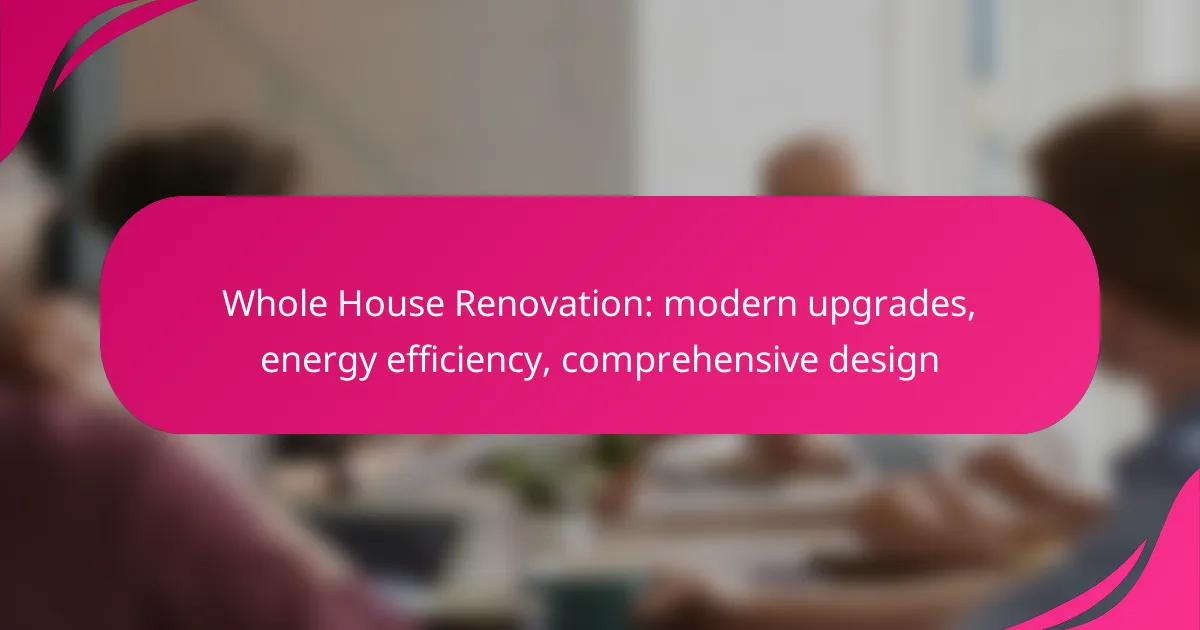A whole house renovation offers an opportunity to integrate modern upgrades that enhance functionality, aesthetics, and energy efficiency. By focusing on smart technology, open layouts, and high-efficiency systems, homeowners can significantly improve comfort and value while reducing energy consumption. Strategic design considerations, including layout planning and material selection, ensure that the renovation meets both practical needs and aesthetic desires.

What modern upgrades enhance whole house renovations?
Modern upgrades that enhance whole house renovations focus on improving functionality, aesthetics, and energy efficiency. Incorporating smart technology, open layouts, and high-efficiency systems can significantly elevate both comfort and value.
Smart home technology
Smart home technology integrates devices that enhance convenience and security. Systems like smart thermostats, lighting, and security cameras can be controlled remotely, allowing homeowners to manage their environments efficiently.
When considering smart upgrades, ensure compatibility with existing systems and prioritize user-friendly interfaces. Popular options include voice-activated assistants and automated lighting systems that adjust based on occupancy.
Open floor plan designs
Open floor plan designs create spacious, interconnected living areas that foster social interaction. This layout often combines the kitchen, dining, and living spaces, making homes feel larger and more inviting.
To implement an open floor plan, consider removing non-structural walls and using furniture to define spaces. This design can enhance natural light flow, making the home feel brighter and more welcoming.
High-efficiency HVAC systems
High-efficiency HVAC systems are designed to reduce energy consumption while maintaining comfort. These systems often use advanced technology to optimize heating and cooling, which can lead to significant savings on utility bills.
When upgrading, look for units with a high Seasonal Energy Efficiency Ratio (SEER) rating. Regular maintenance and proper insulation can further enhance system efficiency and lifespan.
Energy-efficient windows
Energy-efficient windows minimize heat transfer, keeping homes comfortable year-round. These windows typically feature multiple panes, low-emissivity coatings, and gas fills to improve insulation.
When selecting windows, consider the U-factor and Solar Heat Gain Coefficient (SHGC) ratings to ensure optimal performance for your climate. Proper installation is crucial to maximize energy savings.
LED lighting solutions
LED lighting solutions are energy-efficient alternatives to traditional bulbs, using significantly less energy and lasting longer. They come in various styles and can be easily integrated into existing fixtures.
When upgrading to LED, consider the color temperature and brightness to create the desired ambiance. Additionally, utilizing dimmers can enhance energy savings and extend bulb life.

How can energy efficiency be improved in renovations?
Energy efficiency in renovations can be significantly enhanced through strategic upgrades that reduce energy consumption and lower utility bills. Key areas to focus on include insulation, renewable energy sources, energy-efficient appliances, and water-saving fixtures.
Insulation upgrades
Improving insulation is one of the most effective ways to enhance energy efficiency. Upgrading to modern materials like spray foam or rigid foam board can reduce heat loss in winter and keep homes cooler in summer. Consider targeting areas such as attics, walls, and basements for maximum impact.
When selecting insulation, look for R-values that meet or exceed local building codes. In colder climates, aim for R-30 to R-60 in attics, while R-13 to R-21 is suitable for walls. Proper installation is crucial; even the best materials can underperform if not installed correctly.
Solar panel installations
Installing solar panels can drastically reduce reliance on grid electricity and lower energy costs. A typical residential solar system can cover a significant portion of energy needs, especially in sunny regions. Evaluate your roof’s orientation and shading to determine the best setup.
In many areas, government incentives and tax credits can offset installation costs, making solar energy more accessible. Research local regulations and utility programs to maximize savings and ensure compliance with any required permits.
Energy Star appliances
Upgrading to Energy Star-rated appliances can lead to substantial energy savings. These appliances are designed to use less energy and water compared to standard models, often resulting in lower utility bills. Common upgrades include refrigerators, washing machines, and dishwashers.
When shopping for appliances, look for the Energy Star label and compare the estimated annual operating costs. While these models may have a higher upfront cost, the long-term savings typically justify the investment.
Water-saving fixtures
Installing water-saving fixtures is an effective way to enhance energy efficiency, particularly in homes with high water usage. Low-flow showerheads, faucets, and toilets can significantly reduce water consumption without sacrificing performance. These fixtures often use 20-60% less water than traditional options.
Consider retrofitting existing plumbing with these fixtures during renovations. Look for products that meet local water conservation standards and check for certifications like WaterSense, which indicates superior efficiency and performance.

What are the key design considerations for a whole house renovation?
Key design considerations for a whole house renovation include functional layout planning, material selection, and color scheme coordination. Each aspect plays a crucial role in ensuring the renovation meets both aesthetic and practical needs while enhancing energy efficiency.
Functional layout planning
Functional layout planning involves creating a space that optimizes flow and usability. Consider how each room connects and the purpose it serves, ensuring that high-traffic areas are easily accessible and that spaces are appropriately sized for their intended functions.
When planning the layout, think about incorporating open spaces for communal areas while maintaining privacy in bedrooms. Use furniture placement and built-in storage solutions to enhance functionality without sacrificing style.
Material selection
Material selection is critical for durability, maintenance, and energy efficiency. Choose materials that not only fit your design aesthetic but also meet local climate demands, such as energy-efficient windows and sustainable flooring options.
Consider using locally sourced materials to reduce transportation costs and support regional economies. Look for certifications like Energy Star for appliances and LEED for building materials to ensure quality and sustainability.
Color scheme coordination
Color scheme coordination can significantly impact the overall feel of your home. Select a cohesive palette that reflects your personal style while considering the natural light and size of each room. Lighter colors can make small spaces feel larger, while darker shades can create a cozy atmosphere.
Use color swatches to visualize how different hues work together in various lighting conditions. It’s often helpful to choose a dominant color for larger areas and complementary shades for accents, ensuring a harmonious look throughout the home.

What are the costs associated with whole house renovations in urban areas?
The costs of whole house renovations in urban areas can vary significantly based on factors like location, project scope, and materials used. Homeowners should expect to spend anywhere from low tens of thousands to several hundred thousand dollars, depending on the complexity of the renovation and local market conditions.
Average renovation costs in Los Angeles
In Los Angeles, average renovation costs typically range from $100 to $400 per square foot. This wide range reflects variations in design choices, quality of materials, and labor costs. For a standard 2,000 square foot home, total renovation expenses could fall between $200,000 and $800,000.
Homeowners should also consider additional costs such as permits, inspections, and potential unforeseen issues that may arise during the renovation process. It’s advisable to budget an extra 10-20% for contingencies.
Cost breakdown by project type
The cost of renovations can differ greatly depending on the type of project. For example, kitchen remodels often range from $20,000 to $60,000, while bathroom renovations can cost between $10,000 and $30,000. Structural changes, such as adding rooms or altering layouts, can significantly increase overall expenses.
Exterior upgrades, like roofing or siding, typically range from $5,000 to $15,000. Homeowners should prioritize projects based on their budget and the potential return on investment, especially if they plan to sell the home in the near future.
Financing options for homeowners
Homeowners in urban areas have several financing options for whole house renovations. Common choices include home equity loans, which allow you to borrow against your home’s equity, and personal loans, which can provide quick access to funds but may come with higher interest rates.
Another option is a renovation mortgage, which combines the cost of the home and the renovation into one loan. This can be particularly beneficial for buyers looking to purchase a fixer-upper. It’s essential to compare interest rates and terms from various lenders to find the best fit for your financial situation.

What are the prerequisites for a successful renovation project?
A successful renovation project requires careful planning, a clear budget, and a well-defined scope of work. Establishing these prerequisites helps ensure that the renovation meets your expectations and stays within financial limits.
Budgeting for renovations
Budgeting is crucial for any renovation project. Start by determining how much you can afford to spend, including a buffer for unexpected costs, which can range from 10% to 20% of the total budget. Consider all aspects, such as materials, labor, permits, and potential design fees.
When setting your budget, prioritize essential upgrades like structural repairs or energy-efficient installations over cosmetic changes. This approach ensures that your renovation is both functional and sustainable in the long run.
Choosing the right design team
Selecting a qualified design team is vital for the success of your renovation. Look for professionals with experience in whole house renovations and a portfolio that aligns with your vision. Check references and reviews to gauge their reliability and quality of work.
Engage your design team early in the process to ensure they understand your goals and budget. This collaboration can lead to innovative solutions that enhance both aesthetics and functionality while adhering to your financial constraints.
Understanding local regulations
Familiarizing yourself with local building codes and regulations is essential before starting a renovation. These rules can dictate everything from structural changes to energy efficiency standards. Check with your local planning department to understand what permits are required.
Non-compliance with regulations can lead to costly fines or delays, so ensure your design team is well-versed in local requirements. This knowledge will help streamline the renovation process and avoid potential legal issues.
Assessing the current condition of the home
Before beginning renovations, conduct a thorough assessment of your home’s current condition. Identify any structural issues, such as foundation problems or outdated electrical systems, that need addressing. This evaluation will help you prioritize renovations and allocate your budget effectively.
Consider hiring a professional inspector to provide a detailed report on your home’s condition. Their expertise can reveal hidden issues that may impact your renovation plans and costs, ensuring a smoother renovation experience.
